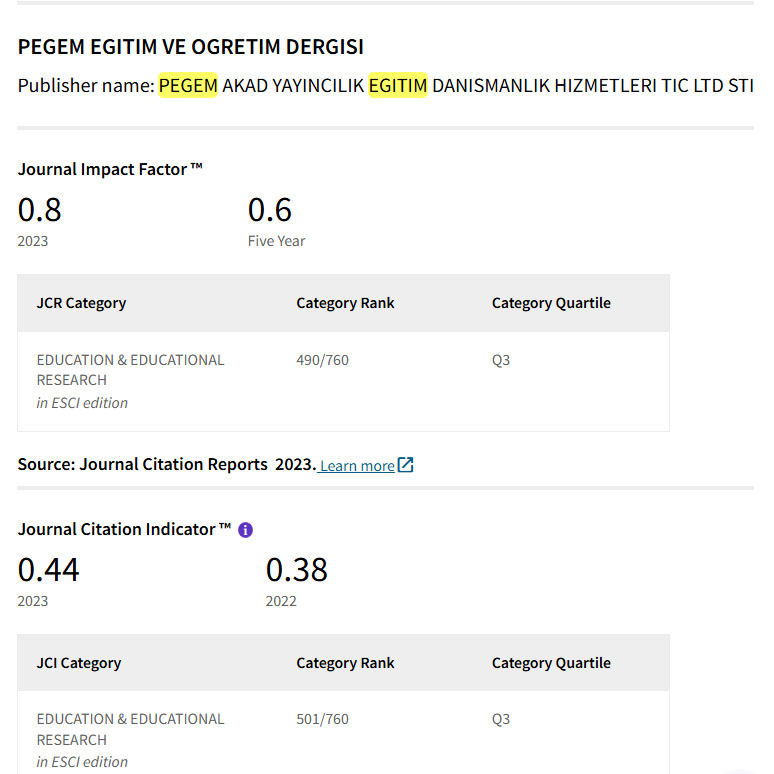Student Perspectives About the Flipped Classroom Model That Used to Improve Civic Literacy
DOI:
https://doi.org/10.47750/pegegog.14.02.31Keywords:
flipped classroom, civic literacy, student perspectiveAbstract
Strengthening civic literacy needs to be done because this can help individuals become more critical, active, and responsible citizens. Strong civic literacy can help a person understand his rights and obligations as a citizen, as well as how to participate in political and governmental processes. It can also help individuals make informed decisions and contribute to building a healthy and just society. Strong civic literacy can also help people control the government and guarantee their human rights. The flipped classroom model is being used in this study to improve students' civic literacy. In order to improve civic literacy and learn about students' opinions of the teaching method, this study intends to investigate how teachers use flipped classrooms. The research method used in this study is a qualitative descriptive method, with interview data collection techniques; observation; and documentation studies. Teachers and students in grade V elementary school were the subjects of this study. The findings show that the teacher used the flipped classroom model to implement four important phases of civic education learning. All stages and activities of the flipped classroom model were well accepted by the students. Students described the flipped classroom as a fun learning model that motivates them to learn more actively and independently, increases learning interest, and piques their curiosity about reading so that they become more knowledgeable about civic literacy.
Downloads
References
Arnold-Garza, S. (2014). The flipped classroom teaching model and its use for information literacy instruction. Communications in Information Literacy, 8(1), 7–22. https://doi.org/10.15760/comminfolit.2014.8.1.161
Bergmann, J., & Sams, A. (2012). Flip your classroom: reach every student in every class every day. Eugene. International Society for Technology in Education.
Bishop, J. L., & Verleger, M. A. (2013). The flipped classroom: A survey of the research. ASEE Annual Conference and Exposition, Conference Proceedings. https://doi.org/10.18260/1-2--22585
Bishop, J., & Verleger, M. (2013). Testing the flipped classroom with model-eliciting activities and video lectures in a mid-level undergraduate engineering course. Proceedings - Frontiers in Education Conference, FIE, 161–163. https://doi.org/10.1109/FIE.2013.6684807
Dallimore, E. J., Hertenstein, J. H., & Platt, M. B. (2013). Impact of Cold-Calling on Student Voluntary Participation. Journal of Management Education, 37(3), 305–341. https://doi.org/10.1177/1052562912446067
Herreid, C. F., & Schiller, N. (2012). Case Studies and the Flipped Classroom View project NAVIGATE Project View project. Article in Journal of college science teaching. https://www.researchgate.net/publication/306146143
Johnson, G. B. (2013). Student perceptions of the flipped classroom in college Algebra. Primus, 25(9), 782–791. https://doi.org/10.1080/10511970.2015.1054011
Kidwell, C. (2006). Civic Literacy and the Civic Mission of Schools. National Social Studies Supervisors Association Journal.
Kong, S. C. (2014). Developing information literacy and critical thinking skills through domain knowledge learning in digital classrooms: An experience of practicing flipped classroom strategy. Computers and Education, 78, 160–173. https://doi.org/10.1016/j.compedu.2014.05.009
Leahey, C. (2011). Negotiating a Parallel Curriculum: Making Space for Critical Civic Literacy in the Social Studies Classroom.” In Critical Civic Literacy: A Reader, edited by Joseph L. DeVitis. Peter Lang.
Lioe, Tirtasanjaya, L., & Wen, T. C. (2012). Assessing the effectiveness of flipped classroom pedagogy in promoting students’ learning experience. NYGH Research Journal.
Mahendra, P. R. A. (2017). Peran Straregi PKn Untuk Membangun Karakter Bagi Mahasiswa. jurnal kajian pendidikan Widya Arccary FKIP Universitas Dwijendra, 8(2), 1–8. https://doi.org/10.46650/wa.8.2.508.%25p
Milner. (2001). Civic Literacy: How Informed Citizen Make Democracy Work. University Press of New England.
O’Flaherty, J., & Phillips, C. (2015). The use of flipped classrooms in higher education: A scoping review. Internet and Higher Education, 25(February 2015), 85–95. https://doi.org/10.1016/j.iheduc.2015.02.002
Obradovich, A., Canuel, R., & Duffy, E. P. (2015). A Survey of Online Library Tutorials: Guiding Instructional Video Creation to Use in Flipped Classrooms. Journal of Academic Librarianship, 41(6), 751–757. https://doi.org/10.1016/j.acalib.2015.08.006
Partnership for 21st Century Skills. (2009).
Roehl, A., Reddy, S. L., & Shannon, G. J. (2013). The Flipped Classroom: An Opportunity To Engage Millennial Students Through Active Learning Strategies. Journal of Family & Consumer Sciences, 105(2), 44–49. https://doi.org/10.14307/jfcs105.2.12
Saputri, R. A., Muchtarom, & Triyanto, W. (2019). Reinforcing civics literacy in sustaining students’ learning in the industrial era 4.0. Universal Journal of Educational Research, 7(9 A), 36–43. https://doi.org/10.13189/ujer.2019.071605
Schlairet, M. C., Green, R., & Benton, M. J. (2014). The flipped classroom strategies for an undergraduate nursing course. Nurse Educator, 39(6), 321–325. https://doi.org/10.1097/NNE.0000000000000096
Strayer, J. (2012). How learning in an inverted classroom influences cooperation, innovation and task orientation. Learning Environment Research, 15(2), 171–193.
Sutrisno. (2019). Penerapan Materi Pendidikan Global pada Mata Pelajaran PPKN di Sekolah Menengah Atas Berbasis Model Project Citizens. Jurnal Pancasila Dan Kewarganegaraan, 4(1), 12–21. https://doi.org/10.24269/jpk.v4.n1.2019.pp12-21
Tachyudin, M., Cahyono, H., & Utami, P. S. (2020). Penguatan Civic Literasi Dalam Membentuk Wawasan Kebangsaan. Civic-Culture: Jurnal Ilmu Pendidikan PKn dan Sosial Budaya, 4(2), 31–39. http://publikasi.stkippgri-bkl.ac.id/index.php/CC/article/view/434
Wigfield, A., & Cambria, J. (2010). Students’ achievement values, goal orientations, and interest: Definitions, development, and relations to achievement outcomes. Developmental Review, 30(1), 1–35. https://doi.org/10.1016/j.dr.2009.12.001
Downloads
Published
How to Cite
Issue
Section
License
Copyright (c) 2023 Pegem Journal of Education and Instruction

This work is licensed under a Creative Commons Attribution-NonCommercial 4.0 International License.
Attribution — You must give appropriate credit, provide a link to the license, and indicate if changes were made. You may do so in any reasonable manner, but not in any way that suggests the licensor endorses you or your use.
NonCommercial — You may not use the material for commercial purposes.
No additional restrictions — You may not apply legal terms or technological measures that legally restrict others from doing anything the license permits.



